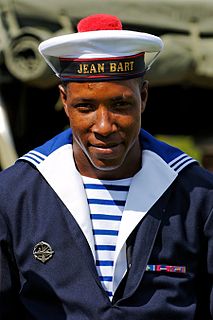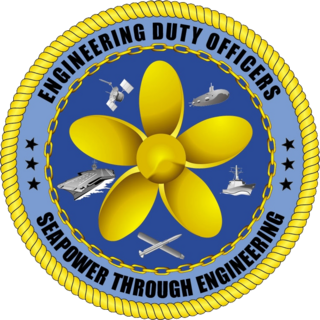Commodore is a senior naval rank used in many navies which is equivalent to brigadier and air commodore. It is superior to a navy captain, but below a rear admiral. It is either regarded as the most junior of the flag officers rank or may not hold the jurisdiction of a flag officer at all depending on the officer's appointment. Non-English-speaking nations commonly use the rank of flotilla admiral, counter admiral, or senior captain as an equivalent, although counter admiral may also correspond to rear admiral lower half abbreviated as RDML.

Grace Brewster Murray Hopper was an American computer scientist and United States Navy rear admiral. One of the first programmers of the Harvard Mark I computer, she was a pioneer of computer programming who invented one of the first linkers. Hopper was the first to devise the theory of machine-independent programming languages, and the FLOW-MATIC programming language she created using this theory was later extended to create COBOL, an early high-level programming language still in use today.
Rear admiral is a senior naval flag officer rank, equivalent to a major general and air vice marshal and above that of a commodore and captain, but below that of a vice admiral. It is regarded as a two star "admiral" rank. It is often regarded as a two-star rank with a NATO code of OF-7.

Military ranks are a system of hierarchical relationships, within an armed forces, police, intelligence agencies or other institutions organized along military lines. The military rank system defines dominance, authority, and responsibility in a military hierarchy. It incorporates the principles of exercising power and authority into the military chain of command – the succession of commanders superior to subordinates through which command is exercised. The military chain of command constructs an important component for organized collective action.
Lieutenant commander is a commissioned officer rank in many navies. The rank is superior to a lieutenant and subordinate to a commander. The corresponding rank in most armies and air forces is major, and in the Royal Air Force and other Commonwealth air forces is squadron leader.
In the United States Navy, officers have various ranks. Equivalency between services is by pay grade. United States Navy commissioned officer ranks have two distinct sets of rank insignia: On dress uniform a series of stripes similar to Commonwealth naval ranks are worn; on service khaki, working uniforms, and special uniform situations, the rank insignia are identical to the equivalent rank in the US Marine Corps.

Seaman is a military rank used in many navies around the world. It is considered a junior enlisted rank and, depending on the navy, it may be a single rank on its own or a name shared by several similarly-junior ranks.

A United States Aviator Badge refers to three types of aviation badges issued by the United States Armed Forces, those being for Air Force, Army, and Naval aviation.

The commandant of the Coast Guard is the service chief and highest-ranking member of the United States Coast Guard. The commandant is an admiral, appointed for a four-year term by the president of the United States upon confirmation by the United States Senate. The commandant is assisted by a vice commandant, who is also an admiral, and two area commanders and two deputy commandants, all of whom are vice admirals.
A flag officer is a commissioned officer in a nation's armed forces senior enough to be entitled to fly a flag to mark the position from which the officer exercises command.
Admiral is a four-star commissioned officer rank in the United States Navy, the United States Coast Guard, and the United States Public Health Service Commissioned Corps with the pay grade of O-10. Admiral ranks above vice admiral and below fleet admiral in the Navy; the Coast Guard and the Public Health Service do not have an established grade above admiral. Admiral is equivalent to the rank of general in the other uniformed services. The National Oceanic and Atmospheric Administration Commissioned Officer Corps has never had an officer hold the grade of admiral. However, 37 U.S.C. § 201 of the U.S. Code established the grade for the NOAA Corps, in case a position is created that merits the four-star grade.
Commodore was an early title and later a rank in the United States Navy, United States Coast Guard and the Confederate States Navy. For over two centuries, the designation has been given varying levels of authority and formality.
This article covers the organization of the United States Coast Guard.
In the United States uniformed services, captain is a commissioned-officer rank. In keeping with the traditions of the militaries of most nations, the rank varies between the services, being a senior rank in the naval services and a junior rank in the ground and air forces. Many fire departments and police departments in the United States also use the rank of captain as an officer in a specific unit.

An officer of one-star rank is a senior commander in many of the armed services holding a rank described by the NATO code of OF-6. The term is also used by some armed forces which are not NATO members. Typically, one-star officers hold the rank of commodore, flotilla admiral, senior colonel, brigadier general, brigadier, or in the case of those air forces with a separate rank structure, air commodore.
United States Coast Guard officer rank insignia describes an officer's pay-grade. Rank is displayed on collar devices, shoulder boards, and on the sleeves of dress uniforms.

A rear admiral in the U.S. uniformed services is either of two different ranks of commissioned officers: one-star flag officers and two-star flag officers. By contrast, in most nations, the term "rear admiral" refers to an officer of two-star rank.

Lieutenant commander is a Junior Officer rank in the United States Navy, the United States Coast Guard, the United States Public Health Service Commissioned Corps, and the National Oceanic and Atmospheric Administration Commissioned Officer Corps, with the pay grade of O-4 and NATO rank code OF-3. When introducing a lieutenant commander their full rank should always be used; however, in general conversation they are usually called "commander" even though they are not a "full" commander. Never use just "lieutenant" because it is one rank lower. The predecessors of the NOAA Corps, the United States Coast and Geodetic Survey Corps (1917–1965) and the Environmental Science Services Administration Corps (1965–1970), also used the lieutenant commander rank, and the rank is also used in the United States Maritime Service and the United States Naval Sea Cadet Corps. Lieutenant commanders rank above lieutenants and below commanders. The rank is equivalent to a major in the United States Army, United States Air Force, and United States Marine Corps.

An engineering duty officer (EDO) is a restricted line officer in the United States Navy, involved with the design, acquisition, construction, repair, maintenance, conversion, overhaul and disposal of ships, submarines, aircraft carriers, and the systems installed aboard. As of August 1, 2016, there are approximately 835 engineering duty officers on active duty in the U.S. Navy, representing approximately 2 percent of its active-duty commissioned officers.

In the United States Navy, United States Coast Guard, United States Public Health Service Commissioned Corps (USPHS), and National Oceanic and Atmospheric Administration Commissioned Officer Corps, captain is the senior-most commissioned officer rank below that of flag officer. The equivalent rank is colonel in the United States Army, Air Force, Space Force and Marine Corps.









